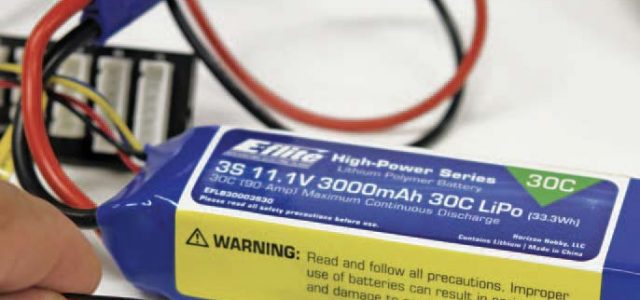The short answer is that when it comes to flight times and motor performance, the higher a battery’s C rating, the more likely it will make you smile. A 45C pack makes a joke of a 10C pack when it comes to power delivery. The C rating for a LiPo battery, quite simply, refers to the capacity of energy the battery can safely discharge, represented as a multiple of its overall capacity. A battery that has a higher C rating delivers more energy, and that means higher performance. The big difference between batteries with different C ratings is the fact that the higher-rated batteries suffer less from voltage drops under load. This ability to maintain a higher and more consistent voltage is what typically generates the high performance we enjoy. This is particularly important when you have multiple motors turning multiple rotors.
A 2000mAh pack will safely deliver 20 amps continuously (10 times 2000mAh equals 20 amps). A 20C pack of the same capacity will safely allow you to draw 40 amps from it continuously. That’s the same capacity and twice the amp draw. There are battery packs out there rated at 30C, 45C, and even 70C that will deliver (in our 2000mAh example) 60, 90, and 140 amps. This major increase in current allows us to run bigger (or more) motors in your multirotor for increased duration and/or payload-lifting capabilities. A higher C discharge rating gives us that extra “oomph” we enjoy in flight, no matter the airframe.
Although a pack with a higher C rating can often be charged in less time because it can tolerate a higher current rate, don’t be in a rush; you can always charge it at 1C (one times the capacity), which will take about an hour for a complete charge. Doing this has produced the best results in our experience; we have some older packs that still operate well after
hundreds of charge and discharge cycles.
Team RotorDrone




















It drives me crazy when people don’t use the correct technical terms. It matters. Energy, Power, Charge, Current. These are all different things. The capacity of a battery is the amount of CHARGE it can store. The units mA-Hr is a measure of CHARGE which also equal to a COULOMB. The ENERGY stored by a battery is the CHARGE multiplied by the “nominal (or average)” voltage. For a lithium battery that is usually 3.7 volts per serial cell. A 3S 5000mAhr battery stores 3.7 * 5(AmpHrs) * 3 = 55.5 Watt-Hours or 55.5 Joules. The C rating defines the MAXIMUM CURRENT you can draw from the battery and it is a multiple of the mA-Hr rating. So a 5000 mA-Hr battery with a 10C rating can deliver 50,000 mA or 50 Amps. At that rate, the battery would fully discharge in 60/10=6 minutes. The maximum POWER available from the battery is the MAX CURRENT multiplied by the nominal voltage. For a 3S, 5000 mA-Hr, 10C battery that would be 5(amps) * 10 * 3.7 * 3 = 166.5 Watts
Randy,
Very informative, thank you! The only problem I’m running into with your calcs is the very last one. 5 * 10 * 3.7 * 3 = 740. where do you come up with the 165.5 watts? what am i missing?
My LiPo pack for my still-in-progress build is 7ah 4S (14.8v nominal) 100C continuous. which using the same calculation comes out to 10360. there’s obviously a calculation I’m missing. I thought divide by 60, or even divide by 55.5, but those numbers are far too small. Would greatly appreciate a further detailed explanation if you don’t mind. You can mail me if you prefer. its kalethis@ the google (g)mail provider (avoiding scrapers). Thanks in advance!
5 amps (5000ma) * 10c * 3.7volts * 3 cells.
Instead of 3.7v * 3 cells just use your volts of 14.8v.
watts = volts * amps
5*10*3.7*3 = 555
Correction. mA-Hr = 1 milli Coulomb.
1 Amp-Hr = 1 Coulomb
one coulomb is 1 ampere per sec. so 3.6 coulomb is mAhr.
Wrong again. 1 amp = 1 coulomb PER SECOND. So an amp-hr is 3,600 coulombs.
1 Coulomb is 1 amp-second
1 amp-hour is 3600 Coulomb
Hi guys,
You seem well informed therefore I want to ask about that C value.
I have bought drone emax babyhawk II hd and recommeneded battery for that is Tattu 4S 850mAh 40C. I can’t get that battery and I wonder if 4S 750mAh 95C would be ok for that. Or what is best alternative for that?
Thank you in advance for your reply.
The discharge voltage of the high discharge rate (C-rate) battery is higher. The voltage drop of high discharge rate battery is smoother than the ordinary one, and the capacity is also greater.
This is from the Grepow Battery Blog, the parent company of Tattu / Gensace.
It’s been awhile since transmission media in college and power = energy …. Anyhow. when it comes to C rating the charge is drawn out or is there like a boundary where its too much for certain ESC’s where it could burn out?
I’m just a few months into the hobby